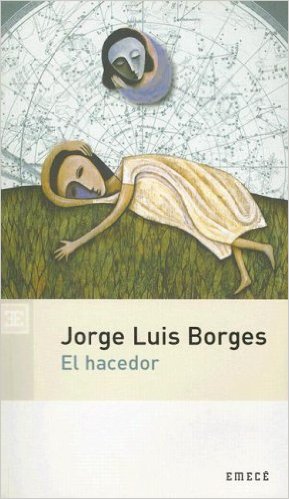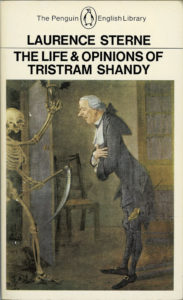Once, near Shanidar in northern Iraq, a young Neanderthal saw his cousin Nandy, who was trying to catch a wild goat, slip on the loose stones and tumble out of sight. The hunter had time enough, as he scrambled down the cliff, to realize that his friend Nandy would be dead before he reached the dessert floor.
Category: Metafiction
Two Kinds of People
There are two kinds of people in the world:
those who divide the world into two kinds of people and those who don’t.
Ronosaurus and I Present “Borges and I”
 Borges’ “Borges and I” is such a wonderful piece of metafiction that I will just reproduce it whole for you here, with just enough of a comment to suggest that writing writes the writer, as I discussed in Who is Writing This? and It’s All Fiction, in which I discuss how every piece of writing requires the invention of a speaker, even a dictionary entry (the “nobody” speaker), so the requirements of the piece determines the voice and therefore the speaker. In the short fiction below, Borges is talking about how his fame has taken over his life (or, as Foucault would put it, his author function, his reputation as a great writer, has erased the real person).
Borges’ “Borges and I” is such a wonderful piece of metafiction that I will just reproduce it whole for you here, with just enough of a comment to suggest that writing writes the writer, as I discussed in Who is Writing This? and It’s All Fiction, in which I discuss how every piece of writing requires the invention of a speaker, even a dictionary entry (the “nobody” speaker), so the requirements of the piece determines the voice and therefore the speaker. In the short fiction below, Borges is talking about how his fame has taken over his life (or, as Foucault would put it, his author function, his reputation as a great writer, has erased the real person).
History is an Angel Blown Backward Through Time
Walking Backwards Through Time
We walk backwards through life, only seeing where we have been, not where we are going. From a physicist’s perspective, it is not clear why this is true. If we accept time as the fourth dimension and state that the universe is a four-dimensional object, why does our consciousness seem to move only in one direction along only one of four possible axes, yet we are only able to see in the direction opposite to our movement? This is not the only possibility imaginable. Many claim, for instance, that God is omnipresent in time as well as space, existing in all epochs at once, in other words he is outside of the illusion of time.
Continue reading “History is an Angel Blown Backward Through Time”
If Not a Pipe, Then What?: Magritte’s Meta-Painting The Treachery of Images
When first I came across René Magritte’s famous painting La trahison des images (The Treachery of Images), which says underneath a pipe in French “Ceci n’est pas une pipe”: “This is not a pipe,” I was quite confused. Of course it is a pipe. Just look at the painting!
I propose a simple test to check whether or not it actually is a pipe: put something in the pipe and smoke it. You can’t? Why not? If not a pipe, then what is it?

Continue reading “If Not a Pipe, Then What?: Magritte’s Meta-Painting The Treachery of Images”
Las Meninas: A Metapainting
Las Meninas is a truly great metapainting, a painting about paintings. A meta–painting is a painting about paintings, a painting about painters, a painting about the process of painting, a painting that reminds viewers that they are looking at a painting rather than real objects, a painting that breaks the conventions of painting, a painting that obscures its borders or plays with levels of reality. Las Meninas does all these things.
At this point I count at least 23 meta aspects. Take a look at the painting yourself and see how many you can identify:
This is not the title of another post on Tristram Shandy
because I am still considering what title I want to use. Although I have already written about the play of form in Laurence Sterne’s book (Tristram Shandy ****s Up the Page, Progressive Digressions in Tristram Shandy, and The Stuff That Dreams are Made Of), there is so much more to say! I feel I could go on exploring metafictional elements in Tristram Shandy for years and never get to the bottom of the book. So here are just a couple of additions to my earlier observations of metafiction in Laurence Sterne’s masterpiece.
Continue reading “This is not the title of another post on Tristram Shandy”
The Stuff That Dreams Are Made On: Paper, Ink, Letter and Word
00011011100010101111001000011010111010010101001001111010001000000101010101110
cvlkjva [-09w8u} =t04 olsd; lkcmvfdkn [goiwe[oidufalkdm;olwih[ot9iyu=frik]; lfdkvna; leirthj ofiu so fijgs; lkrjt
word though there Sterne is attention black and of aware deal recommend the stridulous parcel burn it
In Tristram Shandy, Laurence Sterne draws the reader’s attention to the stuff a book is made of: the pages, the spaces, the ink, the letters, and the words. I have already written about this in “Tristram Shandy ****s Up the Page,” but much more could be said about the earliest and still most complete metafictional novel ever written.
Continue reading “The Stuff That Dreams Are Made On: Paper, Ink, Letter and Word”
Progressive Digressions in Tristram Shandy
In my copy of Tristram Shandy, pages 23 to 68 came loose and I joked about mixing them up and reading them in a random order, but it doesn’t work. There is order to the disorder, organization to the chaos.

Continue reading “Progressive Digressions in Tristram Shandy”
Why Read Spenser When Allegory Invites Despayre
When Allegory invited me to a read and feed, I hesitated. He is a thin man, easy to overlook, his yellowish skin almost transparent. He wears a mishmash of musty, old-fashioned clothing: a toga and a biblical robe, medieval hose and cod piece, moccasins and a romantic scarf. Nothing modern, except maybe the combination.
Continue reading “Why Read Spenser When Allegory Invites Despayre”